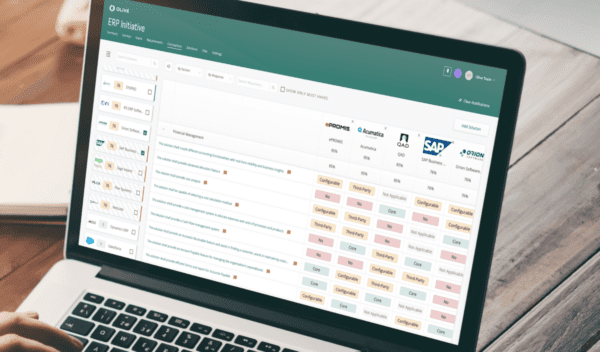An Agile Approach to Digital Transformation
Agile is an increasingly popular term used in the digital transformation realm. Given the past few years, it’s no surprise that business projects these days are unpredictable at best. The Project Management Institute outlines an agile approach to project management that accepts ambiguity and incorporates discovery and learning throughout the project life cycle.
“Many project managers would suggest today that it is nearly impossible to document all requirements, even at a high level, at the beginning of any project, given the speed of economic dynamics. Only after product development commences does the customer begin to realize that what they needed is not exactly what they requested.”
An agile process promotes incremental delivery rather than an “all at once” approach – allowing for frequent inspection and adaptation, teamwork, self-organization and accountability. When this approach is applied to selecting software solutions to drive digital transformation, it gives teams a clear set of best practices that continuously aligns selecting and evaluating software solutions with ever-changing company needs and goals.
Digital transformation enables organizations to be future-proof to keep up with rapidly changing factors: external competitors, industry trends, and new technologies. With this in mind, an agile approach to digital transformation will ensure that teams can swiftly adapt and deliver value – the key to innovation and thriving in an increasingly digital environment. How can your digital transformation include agile processes at its core? In this article, we will examine the top benefits of an agile approach to digital transformation.
What is Agile Digital Transformation?
“Agile digital transformation is based on evidence that successful digital transformations occur through continuous innovation – by radically changing business models and capabilities in measured steps, over time, and as resources allow. This empowers organizations to launch, learn, and re-launch digital initiatives, swiftly reacting to changing market conditions and customer needs.”
Approaching digital transformation in an agile way essentially means added value: teams deliver faster, with greater quality and predictability and greater aptitude to respond to change. Instead of solely relying on one big launch, an agile team delivers work in smaller, more manageable increments. The agile approach also means that teams can respond to change quickly – a necessity when implementing digital transformation – as requirements, plans, and results are evaluated continuously. What’s more, because the agile approach includes incremental development, it fosters an environment of ongoing collaboration with key stakeholders to ensure that the organization is buying solutions that will actually drive digital transformation.
10 Benefits of Agile Digital Transformation
Now that we have looked at the application of agile within the context of digital transformation, let’s explore the many benefits that is has to offer:
1. Flexibility
A core benefit of agility is the flexibility it offers. Traditionally, new business projects can be executed via a strictly rigid approach, which offers little adaptability – particularly at the beginning of the project. On the flip side, an agile approach to digital anticipates and accepts change – and acts accordingly to accommodate it. This offers teams a far more realistic approach: they are empowered to test and switch in accordance with changes. Similarly, if business priorities shift throughout the project, teams will have the ability to make changes throughout the process.
“An agile approach to digital anticipates and accepts change – and acts accordingly to accommodate it.”
–Darrell Rigby, Jeff Sutherland, Hirotaka Takeuchi
2. Business Value Comes First
The agile approach recognizes that technology alone is not a digital transformation solution, instead, it is a people-centric process first and foremost: engaging the right stakeholders to find the right technology. Only once teams have collaborated with stakeholders to define the business challenges clearly, objectives and goals should digital transformation begin. The agile process starts with the ‘why’: aligning the entire approach to respond to stakeholder and business needs.
3. Continuous Improvement
An agile digital transformation process promotes disciplined project management that encourages consistent inspection and adaptation, a leadership philosophy that encourages teamwork, self-organization and accountability. All of these factors contribute to continuous improvement. Unlike a waterfall process, agile teams are continually learning, collaborating, optimizing and making necessary changes throughout regular evaluations – analyzing what is working well, and what needs improvement. Through this process, every individual on the team can contribute to continuous improvement at each stage of the project. The goal is, your process of transformation should have an overarching business goal, identified in collaboration with your stakeholders, and including the means for continuous improvement allows for an agile digital transformation to take place.
4. Frequent Value Delivered
When teams work in bursts of short, productive sprints, digital transformation can occur incrementally – which is the safest, and most effective method of implementation. Rushing digital transformation can have catastrophic consequences, so instead, begin with smaller, agile change efforts that still pack a punch. Rather than waiting for months for an outcome that may not even positively serve your business, take time to create a framework for your company and communicate how the digital transformation serves your organization’s visions and goals.
Perhaps you need to cut costs, change the direction of your business, adapt to the new behaviors of your consumers, boost productivity or relieve bottlenecks caused by legacy software. Whatever the solution may be, incremental changes can help to nip any potential issues in the bud – rather than waiting and implementing changes when it’s too late – and too costly to do so.
5. Cost Control
Digital transformation is about making processes cheaper, faster, and more productive using technology. An agile digital transformation can also reduce the cost of resources, improve productivity and grow revenue. However, without the right agile processes and technological tools in place, you will be shooting in the dark. Incremental project sprints, which are roughly the same in length – enables teams to know exactly how much work can be accomplished, and therefore decipher the cost for each sprint. This means that there won’t be any nasty surprises at the end of the project, and it also allows for budget refinements and changes to be implemented throughout.
Waterfall Digital Transformation Process

Agile Digital Transformation Process

6. Risk Reduction
Digital transformation can be risky business.
But it doesn’t have to be! In fact, an agile approach to software selection massively decreases any risk factors associated with digital transformation and enables projects to practically eliminate the chance of failure. Frequent updates, consistent communication, and collaborative feedback ensures every issue is caught and addressed – minimizing risk and dealing with problems in the early stages of implementation.
7. Communication And Organization Buy-In
Companies will never achieve digital transformation with just one team. In order to be successful, cross-functional teams need to collaborate, and stakeholders need to be included at every stage of the project. The agile process promotes unison, promotes regular communication, consistent collaboration, feedback sessions and continuous stakeholder management, which is crucial to the long-term success of digital transformation efforts.
‘’Successful digital transformation is about gaining consensus to find the right technology that will be adopted by your organization and transform business processes for the better.’’
–Chris Heard, CEO and CoFounder of Olive Technologies
8. Complete Transparency
Regular collaboration organically elicits a higher degree of transparency. The agile digital transformation process, with its regular collaboration, communication and updates between multiple teams allows for greater transparency across the business. The agile process ensures that every team member is aligned with key stakeholders. Daily updates and progress charts offer a tangible solution to track progress and manage expectations across the board.
9. Implementation Success
An agile digital transformation process that includes key stakeholder perspectives leads to higher implementation rates down the line because optimization starts from the get-go. This allows for issues that may hinder implementation to naturally be spotted and addressed quickly. Within a digital transformation context, agility encourages teams to approach projects from an innovative perspective.
10. Higher Team Morale
Simply put, change or innovation cannot occur without people at the core of the project. In order to create a high-performing team, the agile method works because it promotes self-management, creativity, time to reflect, regular knowledge sharing, and continuous learning. What’s more, teams that follow the agile approach increase collaboration, fostering new and innovative ideas.
How Olive can help Your Organization Achieve Agile Digital Transformation
Digital transformation is not just about finding new technology, it’s about continuous agile collaboration with key stakeholders to ensure that you are procuring solutions that will actually drive digital transformation. “sometimes you have to slow down to speed up” is a fitting saying when it comes to the agile approach. Digital transformation simply cannot be effective if it is rushed. The incremental and measured approach that agile provides offers a clear advantage. Flexibility, continuous improvement, stakeholder engagement, higher team morale, and complete transparency are just a few of the many benefits that agile digital transformation enables. Skipping steps, and not doing due diligence may cause your project to drag on, incomplete for years.
Using the tools created to facilitate an agile digital transformation process can help mitigate risk.
Olive is the ultimate tool for enabling agile digital transformation as it guides you through all the major milestones of the software selection process and facilitates ahttps://youtu.be/Qh1zbMC19RI?si=6KepuBh8WqxtxGbqn agile collaborative process.
With Olive, you will find the right enterprise technology for your company’s specific needs. We know that building collaboration into your digital transformation process from the get-go, results in higher user adoption down the line.

Olive has reengineered agile digital transformation to help transparent collaboration with key stakeholders. Olive’s customers see high user adoption results because they leverage our tool and services to work in ways that engage leaders, stakeholders and relevant employees regardless of your industry or business size. The same hurdles for getting buy-in are completely circumvented by giving all on your team a voice. Using Olive, you can maintain a dashboard of project milestones and communicate how the project is doing to your c-suite execs. Olive allows you to digitally transform efficiently in the right way with the guidance and support from expert professionals.
A waterfall approach to digital transformation just won’t work.
Citations
-White, K. R. J. (2008). Agile project management: a mandate for the changing business environment. Paper presented at PMI® Global Congress 2008—North America, Denver, CO. Newtown Square, PA: Project Management Institute.
–Darrell Rigby, Jeff Sutherland, Hirotaka Takeuchi Embracing Agile, How to master the process that’s transforming management





